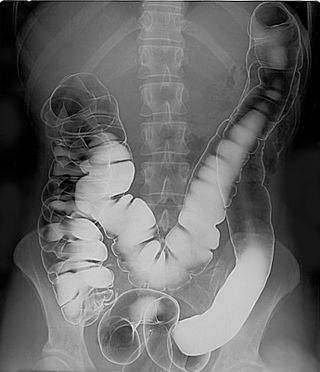External links
- Enterostomal therapist entry in the public domain NCI Dictionary of Cancer Terms
![]() This article incorporates public domain material from Dictionary of Cancer Terms. U.S. National Cancer Institute.
This article incorporates public domain material from Dictionary of Cancer Terms. U.S. National Cancer Institute.
An enterostomal therapist is a health professional trained in the care of persons with stomas, such as colostomies or urostomies. An enterostomal therapy nurse, or ET nurse, is specialized in treating patients who have ostomies, wounds, or incontinence.
![]() This article incorporates public domain material from Dictionary of Cancer Terms. U.S. National Cancer Institute.
This article incorporates public domain material from Dictionary of Cancer Terms. U.S. National Cancer Institute.

Acute myeloblastic leukemia without maturation is a quickly progressing disease in which too many immature white blood cells are found in the blood and bone marrow.

Adenosquamous carcinoma is a type of cancer that contains two types of cells: squamous cells and gland-like cells. It has been associated with more aggressive characteristics when compared to adenocarcinoma in certain cancers. It is responsible for 1% to 4% of exocrine forms of pancreas cancer.
ALVAC-CEA vaccine is a cancer vaccine containing a canary pox virus (ALVAC) combined with the carcinoembryonic antigen (CEA) human gene.
Antiestrogens, also known as estrogen antagonists or estrogen blockers, are a class of drugs which prevent estrogens like estradiol from mediating their biological effects in the body. They act by blocking the estrogen receptor (ER) and/or inhibiting or suppressing estrogen production. Antiestrogens are one of three types of sex hormone antagonists, the others being antiandrogens and antiprogestogens. Antiestrogens are commonly used to stop steroid hormones, estrogen, from binding to the estrogen receptors leading to the decrease of estrogen levels. Decreased levels of estrogen can lead to complications in sexual development. Antiandrogens are sex hormone antagonists which are able to lower the production and the effects that testosterone can have on female bodies.

Antiprogestogens, or antiprogestins, also known as progesterone antagonists or progesterone blockers, are a class of drugs which prevent progestogens like progesterone from mediating their biological effects in the body. They act by blocking the progesterone receptor (PR) and/or inhibiting or suppressing progestogen production. Antiprogestogens are one of three types of sex hormone antagonists, the others being antiestrogens and antiandrogens.

Atamestane, also known as metandroden, as well as 1-methylandrosta-1,4-diene-3,17-dione, is a steroidal aromatase inhibitor that was studied in the treatment of cancer. It blocks the production of estrogen in the body. The drug is selective, competitive, and irreversible in its inhibition of aromatase.
Collagen disease is a term previously used to describe systemic autoimmune diseases, but now is thought to be more appropriate for diseases associated with defects in collagen, which is a component of the connective tissue.

A double-contrast barium enema is a form of contrast radiography in which x-rays of the colon and rectum are taken using two forms of contrast to make the structures easier to see. A liquid containing barium is put into the rectum. Barium is a silver-white metallic compound that outlines the colon and rectum on an x-ray and helps show abnormalities. Air is also put into the rectum and colon to further enhance the x-ray.
Transrectal biopsy is a biopsy procedure in which a sample of tissue is removed from the prostate using a thin needle that is inserted through the rectum and into the prostate. Transrectal ultrasound (TRUS) is usually used to guide the needle. The sample is examined under a microscope to see if it contains cancer.
Transurethral biopsy is a biopsy procedure in which a sample of tissue is removed from the prostate for examination under a microscope. A thin, lighted tube is inserted through the urethra into the prostate, and a small piece of tissue is removed with a cutting loop.
Wedge resection is a surgical procedure to remove a triangle-shaped slice of tissue. It may be used to remove a tumor or some other type of tissue that requires removal and typically includes a small amount of normal tissue around it. It is easy to repair, does not greatly distort the shape of the underlying organ and leaves just a single stitch line as a residual.
The Ewing family of tumors is a group of cancers that includes Ewing tumor of bone, extraosseous Ewing tumors, primitive neuroectodermal tumors, and Askin tumors. Also called EFTs.

A retrospective cohort study, also called a historic cohort study, is a longitudinal cohort study used in medical and psychological research. A cohort of individuals that share a common exposure factor is compared with another group of equivalent individuals not exposed to that factor, to determine the factor's influence on the incidence of a condition such as disease or death. Retrospective cohort studies have existed for approximately as long as prospective cohort studies.
Spindle cell carcinoma is a type of cancer that begins in the skin or in tissues that line or cover internal organs and that contains long spindle-shaped cells. It is also called sarcomatoid carcinoma.
Population study is an interdisciplinary field of scientific study that uses various statistical methods and models to analyse, determine, address, and predict population challenges and trends from data collected through various data collection methods such as population census, registration method, sampling, and some other systems of data sources.
Plaque radiotherapy is a type of radiation therapy used to treat eye tumors. A thin piece of metal with radioactive seeds placed on one side is sewn onto the outside wall of the eye with the seeds aimed at the tumor. It is removed at the end of treatment, which usually lasts for several days.
Ribonucleotide reductase inhibitors are a family of anti-cancer drugs that interfere with the growth of tumor cells by blocking the formation of deoxyribonucleotides.
Embryoma is a mass of rapidly growing cells believed to originate in embryonic (fetal) tissue. Embryonal tumors may be benign or malignant, and include neuroblastomas and Wilms tumors. Also called embryoma. Embryomas have been defined as: "Adult neoplasms expressing one or more embryo-exclusive genes."

Nurses in Canada practise in a wide variety of settings, with various levels of training and experience. They provide evidence-based care and educate their patients about health and disease.
Segmental resection is a surgical procedure to remove part of an organ or gland, as a sub-type of a resection, which might involve removing the whole body part. It may also be used to remove a tumor and normal tissue around it. In lung cancer surgery, segmental resection refers to removing a section of a lobe of the lung. The resection margin is the edge of the removed tissue; it is important that this shows free of cancerous cells on examination by a pathologist.